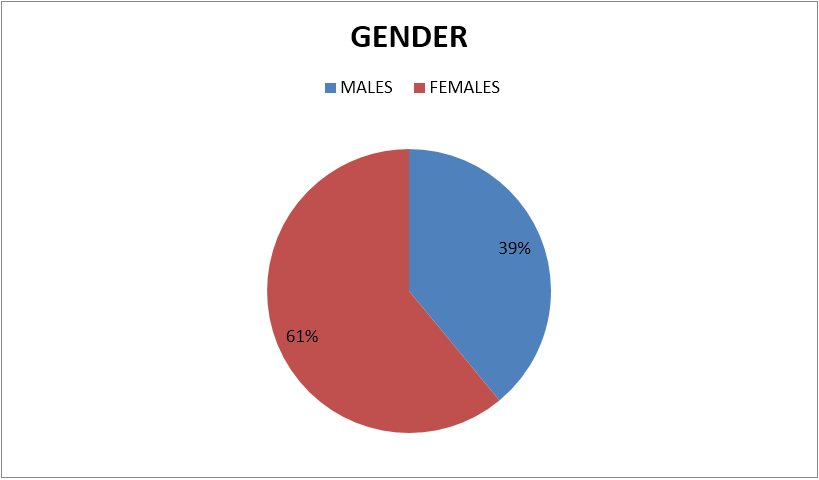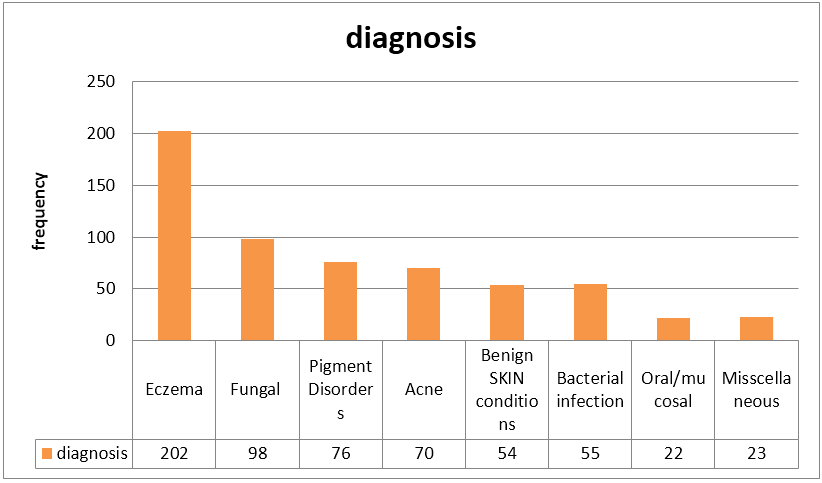Research Article
Volume 3 Issue 1 - 2019
Prevalence of Skin Diseases: A Community Based Survey
1Medical officer, JK health services and Resident Dermatology
2Resident Medical Officer, SKIMS, Srinagar, India
2Resident Medical Officer, SKIMS, Srinagar, India
*Corresponding Author: Mubashar Mashqoor Mir, Medical officer, JK health services and Resident Dermatology, India.
Receieved: December 18, 2018; Published: January 08, 2019
Abstract
Background: Skin diseases are one of the most common health problems.
Objectives: The objectives of this study are to determine the prevalence of skin diseases in a Urban community.
Methods: A community survey was conducted in a urban locality with 3000 inhabitants, to obtain socio-demographic data and identify individuals with skin diseases.
Results: Of 3000 individuals attending the health camps, 600 had one or more Skin diseases. The overall prevalence of SDs was 20.00%.The most common SD categories were eczemas, fungal infection, pigment disorders and acne. The prevalence of the diseases was higher in females. The children were the most common group affected.
Conclusion: Skin disease is very common in community. Targeted training should enable health-care workers to prevent, accurately diagnose and manage these problems on site.
Keywords: Prevalence; Community; Skin disease
Introduction
Skin diseases are one of the most ubiquitous health problems, affecting 1 in 5 persons in the UK and 1 in 3 in the US, but there are large differences between countries, climates and cultures. [1] The highest prevalence has been reported from developing countries and poor areas. In the mountainous region of northern India, the overall prevalence is 45.3%5, while, in rural Sumatra, it is 28.2%. In Africa, reported prevalence figures vary between 11.7% in Bamako, Mali, to 48% in rural Ethiopia. The published prevalence figures in children are also high, 32% in Kenya, 34% in Mali, 31.3% in Hong Kong and 38.8% in northern India.
Figures of this kind reported from various countries are difficult to compare due to differences in study design, the seasonality of certain diseases and uncertainty in terms of census statistics [2]. A major reason for targeting skin diseases in the developing world is that the majority are transmissible and therefore potentially preventable and controllable. Most of the available statistics on the pattern of skin diseases have been based on hospital or private practice, and can provide a very crude indication of true prevalence and incidence in a community, as many social and economic factors affect the decision to seek medical advice. So, the present study was designed to determine the actual extent of the skin disease problem in urban areas [3].
Methods
It was a community survey. All community members consulting for skin problems at the health camp were examined. The majority of diagnoses were based on the patient’s history and clinical signs. Those with recurrent or long lasting SDs were interviewed about symptoms, feelings, daily activities, wearing clothes, social/leisure activities, sport, work/school, personal relationships, sexual activity and treatment. The demographic and clinical data were documented on patient record forms prepared for the study. All patients were provided with free consultations and medicines.
Data Analysis
The data were entered in the SPSS 20.0 program and analyzed.
The data were entered in the SPSS 20.0 program and analyzed.
Results
Out of total 3000 community members. A total of 451 patients had one or other form of disease yielding an overall prevalence rate of 20.00%.
Discussion
The overall prevalence of skin diseases in this study was 20.00%. As in many other studies from developing countries, children and females were more vulnerable than males. One fifth of the inhabitants affected are a fairly high prevalence for SDs, but it is considerably lower than what has been reported from other developing countries in Asia and Africa [4-8]. Eczemas, including photodermatitis, were the most common SDs in our study. The similar findings were obtained by Griils., et al. [4] and Saw SM., et al. [5] The number of infections and infestations were surprisingly low in the studied community. In northern India, infections and infestations accounted for 33%3, in Sumatra 49.5%4 and in Ethiopia 79% [8]. This difference might be due to the fact that our study was conducted uring a relatively cool season and it is well known that there are large seasonal variations in the incidence of skin diseases, especially infectious skin diseases, which are more common in tropical and subtropical climate zones.
Conclusion
Skin diseases are common in the urban communities. With the limited resources available and the lack of dermatologists, we are convinced that information and training for health-care workers will be a cost-effective way to prevent, diagnose, treat or refer these most common skin problems on site.
References
- Mubashar Mashqoor Mir & Mohammad Sarwar Mir., Sch. J. App. Med. Sci., Mar 2018; 6(3): 1302-1304.
- Shrestha D., et al. “Prevalence of skin diseases and impact on quality of life in hilly region of Nepal”. Institute of Medicine. Journal 34.3 (2012): 44-49.
- Abdel‐Hafez K., et al. “Prevalence of skin diseases in rural areas of Assiut Governorate, Upper Egypt”. International journal of dermatology 42.11 (2003): 887-892.
- Grills N., et al. “Prevalence survey of dermatological conditions in mountainous north India”. International journal of dermatology51.5 (2012): 579-587.
- Saw SM., et al. “A population-based prevalence survey of skin diseases in adolescents and adults in rural Sumatra, Indonesia, 1999”.Transactions of the Royal Society of Tropical Medicine & Hygiene 95.4 (2001): 384-388.
- Gibbs S. “Skin disease and socioeconomic conditions in rural Africa: Tanzania”. International journal of dermatology 35.9 (1996): 633-639.
- Satimia FT., et al. “Prevalence of skin disease in rural Tanzania and factors influencing the choice of health care, modern or traditional”. Archives of dermatology 134.11 (1998): 1363-1366.
- Figueroa JI., et al “Dermatology in southwestern Ethiopia: rationale for a community approach”. International Journal of Dermatology 37.10 (1998): 752-758.
Citation:
Mubashar Mashqoor Mir and Susan Jalali. “Prevalence of Skin Diseases: A Community Based Survey”. Chronicles of Pharmaceutical Science 3.1 (2019): 769-772.
Copyright: © 2019 Mubashar Mashqoor Mir and Susan Jalali. This is an open-access article distributed under the terms of the Creative Commons Attribution License, which permits unrestricted use, distribution, and reproduction in any medium, provided the original author and source are credited.


































 Scientia Ricerca is licensed and content of this site is available under a Creative Commons Attribution 4.0 International License.
Scientia Ricerca is licensed and content of this site is available under a Creative Commons Attribution 4.0 International License.